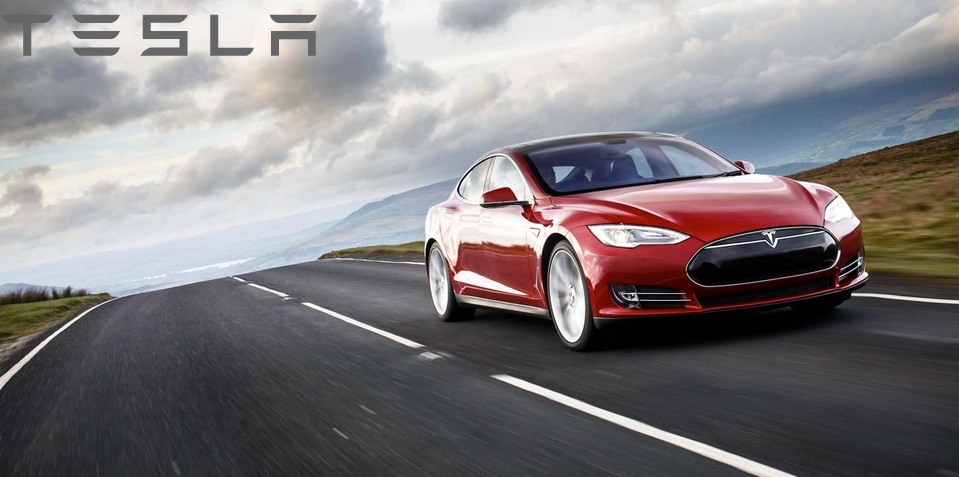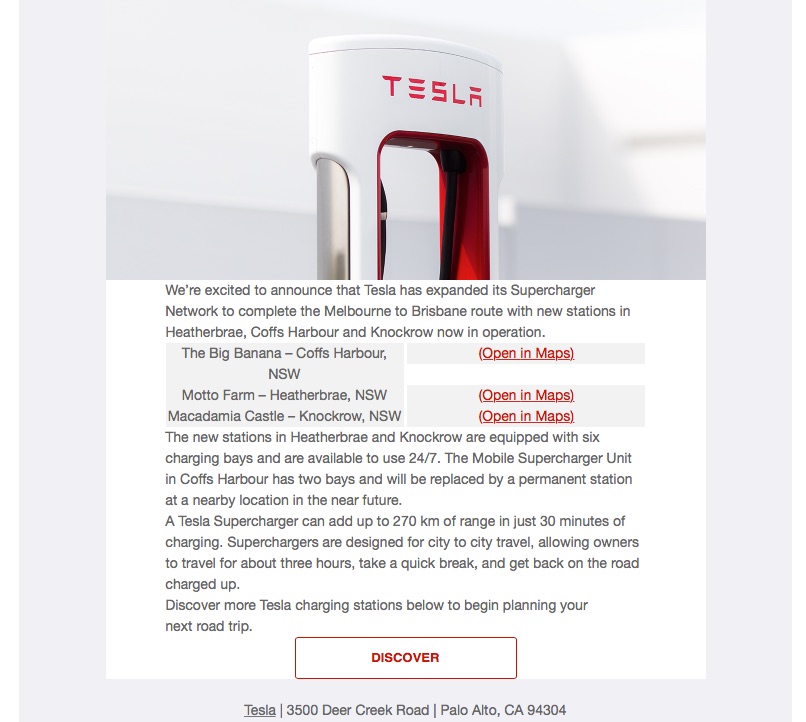News
Tesla completes 1,000-mile long Supercharger corridor in Australia

Tesla Model S and Model X owners can now take an electrified journey from Melbourne to Brisbane using nothing but the company’s fast-charging Supercharger network. The California-based electric car maker has announced the arrival of three new charging stations in Knockrow, Heatherbrae and Coffs Harbour, creating a Supercharger corridor 1,000 miles long (1,600 kilometers) connecting two major Australian cities.
The new Supercharger stations in Heatherbrae and Knockrow are each equipped with six charging stalls, capable of replenishing 170 miles or 270 kilometers of range in as little as 30 minutes of charging time. The Coffs Harbour site is outfitted with two temporary Supercharger bays which Tesla says will eventually be replaced by a permanent location nearby, according to an email sent to Model S and Model X owners in Australia.
Tesla currently has eleven Supercharger stations opened across Australia, with two additional locations in Ballarat and Keith pending construction. According to the company’s find us map, Tesla expects to have a total of eighteen Supercharger stations opened in Australia, one as far as Perth, by the end of this year. To ensure that the company’s entire range of vehicles, including the upcoming mass market Model 3 sedan, can travel between Supercharger stations without experiencing issues related to range, Tesla has strategically spaced stations no more than 150 miles apart, thereby allowing even its lowest range vehicle to travel comfortably between stations. A rear wheel drive Tesla Model S with 60 kWh battery pack is capable of driving 210 miles per single charge. According to Tesla’s website, Model 3 will achieve 215 miles of range per charge.
Below is a copy of the email Tesla sent to Model S and Model X owners in Australia, welcoming the new Supercharger route connecting Melbourne to Brisbane.

Melbourne to Brisbane Supercharger Route is Open
We’re excited to announce that Tesla has expanded its Supercharger Network to complete the Melbourne to Brisbane route with new stations in Heatherbrae, Coffs Harbour and Knockrow now in operation.
- The Big Banana – Coffs Harbour, NSW
- Motto Farm – Heatherbrae, NSW
- Macadamia Castle – Knockrow, NSW
The new stations in Heatherbrae and Knockrow are equipped with six charging bays and are available to use 24/7. The Mobile Supercharger Unit in Coffs Harbour has two bays and will be replaced by a permanent station at a nearby location in the near future.
A Tesla Supercharger can add up to 270 km of range in just 30 minutes of charging. Superchargers are designed for city to city travel, allowing owners to travel for about three hours, take a quick break, and get back on the road charged up.
Discover more Tesla charging stations below to begin planning your next road trip.
Download: Gain access to Tesla’s Supercharger map from your fingertips with our app. iOS | Android | Desktop

News
Tesla starts showing how FSD will change lives in Europe
Local officials tested the system on narrow country roads and were impressed by FSD’s smooth, human-like driving, with some calling the service a game-changer for everyday life in areas that are far from urban centers.

Tesla has launched Europe’s first public shuttle service using Full Self-Driving (Supervised) in the rural Eifelkreis Bitburg-Prüm region of Germany, demonstrating how the technology can restore independence and mobility for people who struggle with limited transport options.
Local officials tested the system on narrow country roads and were impressed by FSD’s smooth, human-like driving, with some calling the service a game-changer for everyday life in areas that are far from urban centers.
Officials see real impact on rural residents
Arzfeld Mayor Johannes Kuhl and District Administrator Andreas Kruppert personally tested the Tesla shuttle service. This allowed them to see just how well FSD navigated winding lanes and rural roads confidently. Kruppert said, “Autonomous driving sounds like science fiction to many, but we simply see here that it works totally well in rural regions too.” Kuhl, for his part, also noted that FSD “feels like a very experienced driver.”
The pilot complements the area’s “Citizen Bus” program, which provides on-demand rides for elderly residents who can no longer drive themselves. Tesla Europe shared a video of a demonstration of the service, highlighting how FSD gives people their freedom back, even in places where public transport is not as prevalent.
What the Ministry for Economic Affairs and Transport says
Rhineland-Palatinate’s Minister Daniela Schmitt supported the project, praising the collaboration that made this “first of its kind in Europe” possible. As per the ministry, the rural rollout for the service shows FSD’s potential beyond major cities, and it delivers tangible benefits like grocery runs, doctor visits, and social connections for isolated residents.
“Reliable and flexible mobility is especially vital in rural areas. With the launch of a shuttle service using self-driving vehicles (FSD supervised) by Tesla in the Eifelkreis Bitburg-Prüm, an innovative pilot project is now getting underway that complements local community bus services. It is the first project of its kind in Europe.
“The result is a real gain for rural mobility: greater accessibility, more flexibility and tangible benefits for everyday life. A strong signal for innovation, cooperation and future-oriented mobility beyond urban centers,” the ministry wrote in a LinkedIn post.
News
Tesla China quietly posts Robotaxi-related job listing
Tesla China is currently seeking a Low Voltage Electrical Engineer to work on circuit board design for the company’s autonomous vehicles.

Tesla has posted a new job listing in Shanghai explicitly tied to its Robotaxi program, fueling speculation that the company is preparing to launch its dedicated autonomous ride-hailing service in China.
As noted in the listing, Tesla China is currently seeking a Low Voltage Electrical Engineer to work on circuit board design for the company’s autonomous vehicles.
Robotaxi-specific role
The listing, which was shared on social media platform X by industry watcher @tslaming, suggested that Tesla China is looking to fill the role urgently. The job listing itself specifically mentions that the person hired for the role will be working on the Low Voltage Hardware team, which would design the circuit boards that would serve as the nervous system of the Robotaxi.
Key tasks for the role, as indicated in the job listing, include collaboration with PCB layout, firmware, mechanical, program management, and validation teams, among other responsibilities. The role is based in Shanghai.
China Robotaxi launch
China represents a massive potential market for robotaxis, with its dense urban centers and supportive policies in select cities. Tesla has limited permission to roll out FSD in the country, though despite this, its vehicles have been hailed as among the best in the market when it comes to autonomous features. So far, at least, it appears that China supports Tesla’s FSD and Robotaxi rollout.
This was hinted at in November, when Tesla brought the Cybercab to the 8th China International Import Expo (CIIE) in Shanghai, marking the first time that the autonomous two-seater was brought to the Asia-Pacific region. The vehicle, despite not having a release date in China, received a significant amount of interest among the event’s attendees.
Elon Musk
Elon Musk and Tesla AI Director share insights after empty driver seat Robotaxi rides
The executives’ unoccupied tests hint at the rapid progress of Tesla’s unsupervised Robotaxi efforts.

Tesla CEO Elon Musk and AI Director Ashok Elluswamy celebrated Christmas Eve by sharing personal experiences with Robotaxi vehicles that had no safety monitor or occupant in the driver’s seat. Musk described the system’s “perfect driving” around Austin, while Elluswamy posted video from the back seat, calling it “an amazing experience.”
The executives’ unoccupied tests hint at the rapid progress of Tesla’s unsupervised Robotaxi efforts.
Elon and Ashok’s firsthand Robotaxi insights
Prior to Musk and the Tesla AI Director’s posts, sightings of unmanned Teslas navigating public roads were widely shared on social media. One such vehicle was spotted in Austin, Texas, which Elon Musk acknowleged by stating that “Testing is underway with no occupants in the car.”
Based on his Christmas Eve post, Musk seemed to have tested an unmanned Tesla himself. “A Tesla with no safety monitor in the car and me sitting in the passenger seat took me all around Austin on Sunday with perfect driving,” Musk wrote in his post.
Elluswamy responded with a 2-minute video showing himself in the rear of an unmanned Tesla. The video featured the vehicle’s empty front seats, as well as its smooth handling through real-world traffic. He captioned his video with the words, “It’s an amazing experience!”
Towards Unsupervised operations
During an xAI Hackathon earlier this month, Elon Musk mentioned that Tesla owed be removing Safety Monitors from its Robotaxis in Austin in just three weeks. “Unsupervised is pretty much solved at this point. So there will be Tesla Robotaxis operating in Austin with no one in them. Not even anyone in the passenger seat in about three weeks,” he said. Musk echoed similar estimates at the 2025 Annual Shareholder Meeting and the Q3 2025 earnings call.
Considering the insights that were posted Musk and Elluswamy, it does appear that Tesla is working hard towards operating its Robotaxis with no safety monitors. This is quite impressive considering that the service was launched just earlier this year.








